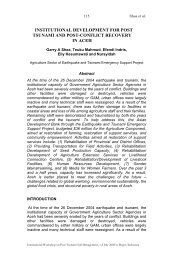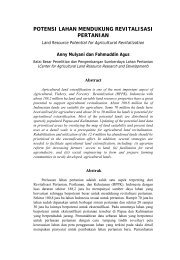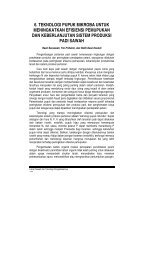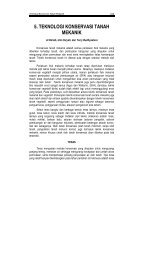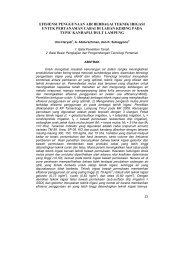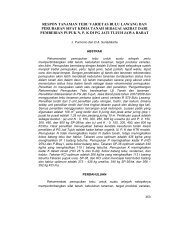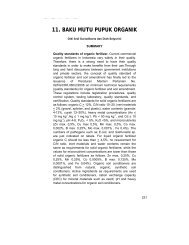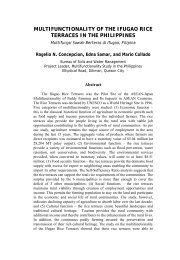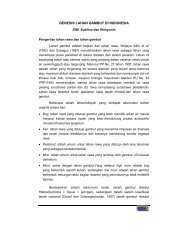Proceedings - Balai Penelitian Tanah
Proceedings - Balai Penelitian Tanah
Proceedings - Balai Penelitian Tanah
Create successful ePaper yourself
Turn your PDF publications into a flip-book with our unique Google optimized e-Paper software.
22<br />
Niino Y<br />
damaged agricultural lands and infrastructures, and reclamation of<br />
salt-affected soils for resumption of crop production. One of the main<br />
challenges was to identify suitable interventions for longer-term<br />
rehabilitation and reconstruction of the agriculture sector in a<br />
sustainable manner best suited to the local agro-ecological and socioeconomic<br />
conditions. An integrated and participatory approach was<br />
needed to identify promising technologies that could be easily adopted<br />
by the farmers.<br />
COUNTRY OVERVIEW<br />
India<br />
In all four states, Andaman and Nicobar, Tamil Nadu, Andhra Pradesh<br />
and Kerala, the standing rice and plantation crops were significantly<br />
impacted upon. The extent of damage incurred due to the tsunami<br />
were over 11 000 ha of agriculture, horticultural and plantation crops<br />
and estimated losses was US$149.58 million.<br />
About 4 000 ha, 2/3 of the total area, of rice crop was lost or severely<br />
affected in Andaman and Nicobar Island (FAO, 2006a). Among the<br />
plantation crops areca nut, coconut and banana stands were severely<br />
affected. Seawater intrusion not only affected the standing crop but<br />
also resulted in the salinization of soils and water bodies. In some<br />
areas in the Andaman and Nicobar Islands land was permanently<br />
inundated and cannot be reclaimed.<br />
Immediate responses by both the Government and NGOs included<br />
the repair of dykes, spillways and irrigation canals; the analysis of soil<br />
samples to assess the extent of salinization; the clearing of debris<br />
from fields; scraping of surface salt from rice fields and plantation<br />
lands; the application of organic amendments to affected fields; the<br />
application gypsum to selected fields; the construction of check dams,<br />
ponds and the supply of pumps; the provision of farm implements and<br />
equipment to affected farmers; provision of emergency cash payouts<br />
to affected persons; the establishment of self-help groups within<br />
affected areas as a means of effecting the rehabilitation process;<br />
creation of awareness amongst farmers in the management of salinity;<br />
and the distribution of salt tolerant crop varieties.<br />
The rehabilitation process has had a major impact in returning the<br />
agricultural sector to its previous level of productivity. Whilst this<br />
sector was initially neglected in the overall recovery process, it has<br />
become evident that the agricultural sector was critical to the<br />
livelihoods of numerous coastal communities. Natural leaching and<br />
flushing of salts facilitated by abnormally high post-tsunami rainfall in<br />
some states and helped crop lands return to pre-tsunami production<br />
levels. The growing of crops such as sun-hemp and sesbania has<br />
been shown to be effective green-manures that can assist in the<br />
International Workshop on Post Tsunami Soil Management, 1-2 July 2008 in Bogor, Indonesia



